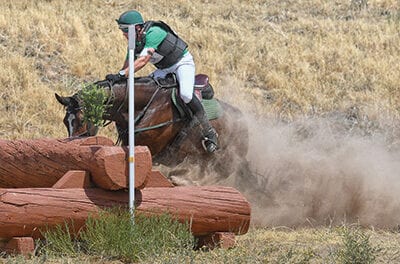In partnership with a horse, one is seldom lacking for thought, emotion or inspiration.
—Charles de Kunffy
Who says you have to ride? So often we think that the time with our horse has to be spent riding. The truth is, there are endless ways to spend time with your horse without riding to build upon your relationship with them. Some horses, due to age, young or old, are not ready to carry a rider yet, or they physically cannot comfortably carry a rider anymore. In the winter months, the footing can be bad, hard or just dangerous for riding. In the most basic sense, training your horse to lead at a good distance, stop when you stop, back up, stand still, respond, and just have good “ground manners” makes them safe and fun to be around, plus builds confidence for both of you. Groundwork can help with coordination, flexibility, balance and fitness, which can all last a lifetime. Beyond these basics, a few profoundly beneficial ways to work with your horse from the ground include long-lining, in-hand work and liberty training.

Personally, my time starting horses in Ireland for flat racing was an incredible introduction to long-lining. Not long before I arrived at Kildangan Stud in Ireland, Buck Brannaman had spent time with the resident horse trainers, teaching the philosophy of handling horses based on classical concepts from the vaquero tradition that he learned from his mentor, Ray Hunt. We started all of the youngsters using the patient and steady methods taught by Buck and listened to the horse to tell us when they were ready for the next step. Then the Irish methods of long-lining (they called it driving) started to be integrated. Once the horses were happily carrying a saddle and bridle, we would double line (one rein on each side of the bit, not attached to anything else) them in the round pen, teaching them to gracefully change directions with ease, walk/trot forward with the trainer behind them, all with lightness and finesse. Working with hundreds of youngsters over the months, you became quite adept with the lines, which was truly an art form to behold.
“I have used long-lining with unfamiliar horses as a safe way to get to know them and see how they react in new situations.”
Once the horses understood all of the double line work in the round pen, we started long-lining them all over the stud (farm/ranch), just like you were on a trail “ride.” They encountered other horses, vehicles, arenas, gallops, and we used things like trees, fences and rocks as obstacles to work around. For horses being readied for other careers in Ireland, they are long-lined through water, up and down banks, over ditches, logs, bridges and whatever you can find. They learn to experience and build confidence without the rider in the equation, and if the youngsters would spook, shy, jump, or whatever, there is no rider to throw them off balance or be endangered. Once they were ready to start carrying a rider, they had already experienced many situations and were used to their person being behind them and figuring out situations in that context.
For older horses, long-lining has great advantages as well. Coming back from injury or time off, long-lining is a great way to safely get them back into work without them using their newfound freedoms to reinjure themselves, or you. It is also an excellent way to build trust with horses who lack confidence. You can introduce them to new areas, objects or situations through long-lining and lunging interchangeably. Almost anywhere you would ride, you can long-line. Take them on the trail, tackle an obstacle course, go through cattle, around a pattern—the benefits are endless. I have used long-lining with unfamiliar horses as a safe way to get to know them and see how they react in new situations.
In-hand work is another method of working with your horse from the ground that may seem similar in some ways to long-lining, but specifically helps work on collection and uphill balance in your horse. You may be familiar with seeing in-hand work at the famous Spanish Riding School or Dressage riders using in-hand work to teach the upper-level movement of piaffe. At the Spanish Riding School, they did not have room to warm up in the saddle for performances, therefore they used in-hand work as their warmup. Whether you ride English or western, in-hand work can be started at the beginning of your horse’s training, too, with exercises and skills appropriate to their level. In-hand work is a great way to work on your horse’s collection and uphill balance without the rider, or to get ready for a ride or do some fitness work during the winter.
Leave the reins and tack behind for some liberty training! Liberty training, as you may know or at least have now gathered, is training your horse without the use of halters, bridles, saddles, ropes, whips or anything other than you and the horse. Your horse has the option to work with you or not, but once you are on the same page, the bond and communication that is established through liberty training can be magical. Some people start liberty training by using halters or a round pen, and some start with a wild mustang in a field and seek to build the relationship from there. Liberty training can be very rewarding and build a true partnership between horse and human. Target and clicker training are sometimes utilized as tools in liberty training. It starts simply with your horse just interested in following you and being interested in what you are doing. This can progress in many directions including teaching movements such as rearing, side-passing, Spanish walk, bowing, and agility work (yes, like dogs do). Liberty work is applied for horses that perform in movies, commercials, and performances such as Cavalia. Unlike long-lining and in-hand work, liberty training does include riding and recently, the International Liberty Horse Association was created to recognize liberty as its own discipline and support horses and their people through events and competitions.
Whether long-lining, in-hand work or liberty training, all three of these will complement your time together with your horse, in or out of the saddle. The nature of the horse to partner with humans and our draw to them is the root of our thousands of years old relationship with them. What can you add to your time together to grow that partnership? Find a local trainer, book, or check out YouTube for inspiration!
The essential joy of being with horses is that it brings us in contact with the rare elements of grace, beauty, spirit, and freedom.
—Sharon Ralls Lemon
Want to target your audience and advertise your horse-related business on this page? Ad space starts for under $200! Contact [email protected] for more information!
©Heather McWilliams 2023


